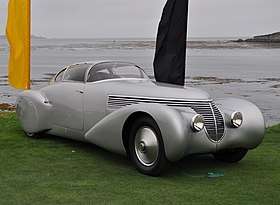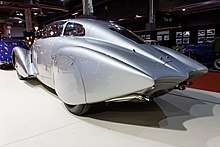Hispano-Suiza H6B Dubonnet Xenia
The Hispano-Suiza H6B Dubonnet Xenia is a one-off luxury car made by Spanish automobile manufacturer Hispano-Suiza for French pilot and racing car driver André Dubonnet in 1938. The car was built on the chassis of the Hispano-Suiza H6B, however it uses the larger, more powerful engine from the H6C and an entirely new body design by luxury coachbuilder Jacques Saoutchik.[1]
| Hispano-Suiza H6B Dubonnet Xenia | |
|---|---|
 | |
| Overview | |
| Manufacturer | Hispano-Suiza |
| Production | 1938 (1 built) |
| Assembly | France: Paris (Bois-Colombes factory) |
| Designer |
|
| Body and chassis | |
| Class | Luxury car |
| Body style | 2-door targa top |
| Layout | Front mid-engine, rear-wheel-drive |
| Doors | Rear-hinged sliding |
| Related | Hispano-Suiza H6 |
| Powertrain | |
| Engine | 8.0 L straight-6 |
| Transmission | 4-speed manual |
| Dimensions | |
| Wheelbase | 4,064 mm (160.0 in) |
| Length | 5,664 mm (223.0 in) |
| Width | 1,956 mm (77.0 in) |
| Height | 1,575 mm (62.0 in) |
History
_Genf_2019_1Y7A5857.jpg)
In the 1920s, André Dubonnet became involved with automobiles as a racing driver for Bugatti and Hispano-Suiza, participating in Grand Prix events like the 1926 Targa Florio and winning the 1922 Autumn Grand Prix at Monza.[2] During this time, Dubonnet developed an automobile steering and suspension system, the système Dubonnet.[3] The Dubonnet suspension featured an independent coil spring and shock absorber system that traded durability for a reduction of unsprung weight and increased comfort.
Dubonnet first installed this suspension system on a custom Hispano-Suiza H6B chassis in 1932.[4] Following coachwork done by Carrosserie Vanvooren's Marius Daste, a prototype car was displayed to the public at the 1932 Paris Motor Show.[5] This prototype was heavily based on the H6B, using the same engine, transmission, and brakes as the production car. It was presented in the sedan body style, with rear suicide doors and a long sweeping tail.[5]
The success of his prototype at the Paris Motor Show was evident in the fact that he soon sold the Dubonnet suspension system to several major automobile manufacturers, including General Motors, Alfa Romeo, Fiat, and Delahaye.[6] In the mid 1930s, Dubonnet's focus shifted from suspension to aerodynamics. In 1935, he partnered with aerodynamicist Jean Andreau to develop the Dubonnet Dolphin, a Ford-based prototype built by Letourneur et Marchand.[7] At a test at the Autodrome de Linas-Montlhéry in 1936, the Dolphin achieved a 35% higher top speed and 25% better fuel economy than a contemporary Ford with the same engine, demonstrating the importance of aerodynamics in design to the Automobile Club of France.[8] The Dolphin prototype was eventually purchased by Henry Ford and shipped to the United States.[7]
Dubonnet's second wife, Xenia Howard-Johnston, passed away prematurely in 1936 after four years of marriage.[9] As a tribute to his late wife, Dubonnet decided to create a further development of his 1932 H6B prototype, a car he would call the Xenia in her memory.[4] The Xenia showcased the Dubonnet independent suspension of the earlier model alongside the streamlined aerodynamics of the later Dolphin, resulting in a car again designed with the help of Andreau with a body built by French coachbuilder Saoutchik. The final product, which now differed substantially from the Hispano-Suiza H6B on which it was based, was finished in 1938.
Specifications
Powertrain
Although based on the chassis of the H6B, the Dubonnet Xenia uses the upgraded straight-6 engine from the H6C model. This 7,983 cc (487 cu in) SOHC engine utilized an aluminum block and a billet steel crankshaft for a lighter and stronger construction.[10] The engine produced 160 hp (119 kW) at 3,050 rpm,[11] able to propel the car to an estimated top speed of around 110 mph (177 km/h) thanks to the slippery aerodynamics of the body.[12]
Transmission
The Dubonnet Xenia was built with a 4-speed manual transmission built by Hispano-Suiza.[11] This is another difference from the production H6 models, all of which used 3-speed manuals.
Suspension
As a showcase of his own automotive inventions, the Dubonnet Xenia utilized Dubonnet's custom independent coil spring suspension at all four wheels. This design was intended to improve the comfort and smoothness of the ride, with Dubonnet claiming the system had "the suppleness of a cat", and likening the experience of driving the car to floating on air.[11]
The Dubonnet Xenia used the standard brakes from the production H6B, which meant servo-assisted alloy brake drums at the front and rear axles.[1]
Exterior features

The exterior of the Dubonnet Xenia features many aviation and Art Deco inspired details owing to the time period and Dubonnet's history as a fighter pilot in World War I. These details include the wraparound windshield, the large slatted grill extending below the long hood, and the unconventional rear-hinged doors that operated by sliding out and back towards the rear of the car.
Dubonnet's focus on aerodynamics can also be seen in the exterior design of the car. The flared front fenders taper off in a teardrop shape towards the rear, as does the tail of the car. Notably, the Dubonnet Xenia has fender skirts that cover almost the entirety of the rear wheels to reduce drag, a technique pioneered 10 years earlier on a land speed record attempt car.[13]
Owners
The H6B Dubonnet Xenia began as André Dubonnet's personal car after it was finished in 1938. Upon the breakout of World War II and the subsequent invasion of France in 1940, the Dubonnet Xenia was hidden. It resurfaced again on June 9, 1946, where it led a parade commemorating the opening of a highway tunnel in Saint-Cloud.[1] In the 1960s, the car was bought and restored by Alain Balleret, president of the French Hispano-Suiza Club.[11]

In 1999, the car again changed hands when it was bought by American collector Charles Morse.
After being restored again by its new owner, the Dubonnet Xenia was displayed at the 2000 Pebble Beach Concours d'Elegance where it won the award for 'Most Elegant Enclosed Car'. It subsequently won Best in Show at the 2001 Amelia Island Concours d'Elegance.[1]
In 2003, the Dubonnet Xenia was purchased by American businessman Peter W. Mullin, the car's current owner.[11] It has since been on display at the Mullin Automotive Museum in Oxnard, California, and has occasionally been loaned to other museums for exhibitions.
References
- Ernst, Kurt (2018-06-21). "1938 Hispano-Suiza H6B Dubonnet Xenia earns Best of Show at Rodeo Drive Concours". Hemmings Daily.
- Harvey, Ian (2016-10-30). "The Hispano-Suiza Dubonnet Xenia: A futuristic vintage luxury car from 1938". The Vintage News.
- DE 644372 and DE 697702
- "Andre Dubonnet". As 14-18.
- "Andre Dubonnet's 1932 Xenia I In Detail". The Old Motor. 2016-09-08.
- "The 1938 Dubonnet Xenia...Where the restoration took place". D&D Classic.
- Renault, Alex (2018-03-13). "Dubonnet Dolphin (1935)". L'automobile Ancienne.
- Simanaitis, Dennis (2016-02-06). "ANDRÉ DUBONNET'S FLIGHT OF AUTOMOTIVE FANCY". Simanaitis Says.
- "André Dubonnet". Geneanet.
- Melissen, Wouter (2004-12-13). "Hispano Suiza H6C Monza". Ultimatecarpage.com.
- "Hispano-Suiza H6B Dubonnet Xenia 1938". Mullin Automotive Museum.
- D, Nick (2016-04-06). "1938 Hispano-Suiza H6C Saoutchik Xenia Coupe". Supercars.net.
- Schultz, Mort (October 1985). "Body/Chassis: a Century of Progress". Popular Mechanics: 59.
External links
| Wikimedia Commons has media related to Dubonnet Hispano-Suiza "Xenia". |